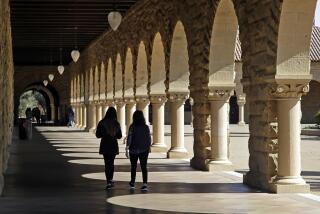Who killed Antioch? Womyn
- Share via
ON JUNE 12, the board of trustees of Antioch College, the famously countercultural institution in Yellow Springs, Ohio, announced that the campus would shut down next year. The decision is a result of declining enrollment, insufficient alumni support and facilities so neglected that, according to several reports, some buildings don’t have hot water. Earlier this year, a number of faculty members were laid off. Meanwhile, student enrollment, which had been about 2,000 in the college’s 1960s heyday, has dwindled to about 400.
Like a handful of other unconventional colleges, Antioch offers “areas of concentration” instead of majors, and issues “narrative evaluations” instead of letter grades. But even in an era when the most common question in a high school classroom is “Are we being graded on this?”, it’s not all that shocking that many prospective students have opted to spend their $35K-a-year tuition and fees at places that have hot water. There’s a difference, after all, between getting back to the garden and actually living in one.
And then there’s the matter of alumni contributions. Even though it was founded in 1852 and has a number of distinguished alumni, Antioch College, the flagship institution of a larger system called Antioch University (there are campuses in Los Angeles and Santa Barbara, among other locations) has an endowment of just $40 million. That’s appallingly low — neighboring Ohio colleges Oberlin and Kenyon have endowments of $700 million and $165 million, respectively.
There’s no lack of speculation as to how this happened. Many have suggested that the career choices of typical Antioch alums (think public servant or activist rather than CEO or law partner) do not lend themselves to generous contributions. Others see a more general problem with liberal philanthropy. In a podcast interview for InsideHigherEd.com, Bard College President Leon Botstein (who in the 1970s was president of the seriously far-out and short-lived Franconia College) came down hard on what he sees as a failure of liberals to support their institutions.
“One of the tragedies of the progressive liberal movement,” Botstein said, “is that unlike at a conservative institution — such as Princeton or Dartmouth, where the alumni are deeply loyal and give it support and money — for liberals, higher education is not a strong enough cause. Their causes are social causes, and higher education is left for the conservatives to fund.”
Whether or not contemporary Princeton or Dartmouth can fairly be characterized as conservative (though, admittedly, you have to declare a major at these places, and it can’t be in roach-clip design), Botstein makes a good point. He also conjectured that Antioch, which he called “the founding college of the American progressive movement,” had been “killed” by, among other things, its own liberalism.
Botstein’s not totally wrong, but as members of his baby boom generation are apt to do, he equates “liberalism” and liberals with the demonstrations of the 1960s and 1970s, including a six-week campus strike in 1973 during which students firebombed buildings to protest racial inequality at the school. But it was the next iteration of liberal excess that really did the place in. To later generations, Antioch is famous for one thing: its Sexual Offense Prevention Policy.
In 1993, it suddenly became national news that Antioch required anyone engaging in sexual activity on campus to ask for and grant permission throughout every step of the encounter. Conceived by a group called Womyn of Antioch, the policy stipulated that consent could not be granted through body movements, nonverbal responses or silence. Furthermore, it stated that “consent is required each and every time there is sexual activity” and that “each new level of sexual activity requires consent.” Translation: dorm room make-out sessions were being punctuated by steamy questions like, “May I kiss you now?”, “May I remove your (Che Guevara) T-shirt now?” and “May I “ (you get the idea).
Admittedly, this was the early ‘90s, a time when many liberal arts campuses were so awash in the hysteria of political correctness that it seemed entirely possible a lamppost could commit date rape. But the attention to the Antioch policy, which got as far as a “Saturday Night Live” sketch, not only came to symbolize the infantilizing dogma of the new left, it turned an already obscure college into a laughingstock.
Obviously, no single factor can be blamed for Antioch’s demise. There appear to be management issues as well as public relations issues at play (and, for the record, the board of trustees is calling the closing a “suspension of operations” with the intention of opening a redeveloped campus in 2012).
Some baby boomers seem inclined to connect the college’s closing with what they view as the career obsession and political apathy of the generations that followed them (as if 40 years of college students can be lumped into one generation). They see their successors as not activist enough or not activist in the right way (or, at least, possessed of unfortunate musical tastes). But, when deciding who’s really “progressive,” it’s worth remembering just how profoundly the college (and, to a lesser extent, others like it) recast its notions of liberalism. It’s not independent thinking that most people associate with Antioch, but an utter lack of it.
mdaum@latimescolumnists.com
More to Read
Sign up for Essential California
The most important California stories and recommendations in your inbox every morning.
You may occasionally receive promotional content from the Los Angeles Times.











